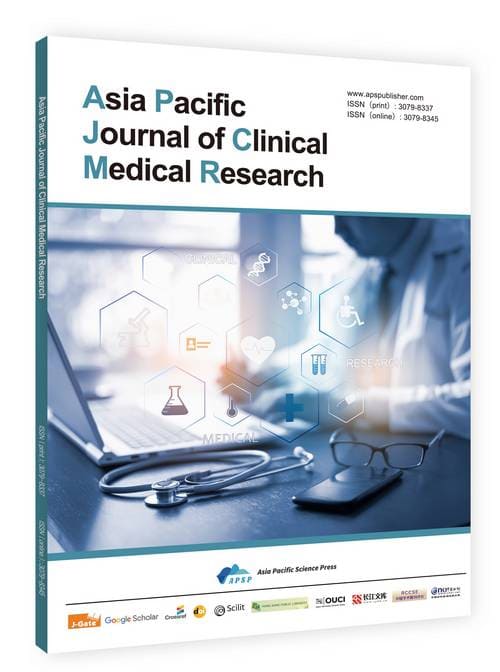Chemical Composition and Effect of Aqueous Extract of Alpinia oxyphylla Miq. on Inhibition of Salmonella typhi
DOI:
https://doi.org/10.62177/apjcmr.v1i5.859Keywords:
Alpinia oxyphylla Miq., Salmonella typhi, Extraction, Antibacterial ActivityAbstract
Objective: To investigate the separation and extraction process of the primary chemical constituents of Alpinia oxyphylla Miq. against Salmonella typhi, and its antibacterial efficacy, providing theoretical basis for novel gastrointestinal epidemic drugs and interventions against pathogen transmission. Methods: Alpinia oxyphylla Miq.: purified water-to-material ratio 1:5, refluxed at 100°C for 6 hours, repeated three times. Alpinia oxyphylla Miq. extract was concentrated by freeze-drying at a 30:1 solid-to-liquid ratio to obtain the final extract. The efficacy of the extraction method and antibacterial activity were assessed using the disk diffusion method. The minimum inhibitory concentration (MIC) and minimum bactericidal concentration (MBC) were determined to establish the minimum therapeutic thresholds. Gas chromatography-mass spectrometry (GCMS) was employed to identify the primary bioactive constituents and their relative concentrations in the Alpinia oxyphylla Miq. aqueous extract. Results: The water extract of Alpinia oxyphylla Miq. Miq. demonstrated potent antibacterial activity against Salmonella typhi (P < 0.001), with an inhibition zone diameter of 8.43 ± 0.11 mm, MIC of 0.25 g/ml, and MBC of 0.5 g/ml. The extraction process was established as follows: Alpinia oxyphylla Miq. : purified water ratio 1:5, reflux heating at 100°C for 6 hours, repeated three times, followed by freeze-drying at 30:1 concentration. This yielded an extract rich in , primarily comprising octadecanoic acid (44.27%), palmitic acid (26.18%), caproic acid (8.15%), 10-hydroxydecanoic acid (7.83%) as the main components, supplemented by 3-hydroxy-dodecanoic acid (1.78%), cis-13-eicosenoic acid (1.58%), valeric acid (1.21%), heptanoic acid (1.13%), nonanoic acid (1.06%), oleic acid (0.87%), and butyric acid (0.47%). Conclusion: This extraction process for novel antimicrobial compounds from Alpinia oxyphylla Miq. demonstrates high stability, operational feasibility, and precise composition and efficacy. It provides a practical theoretical foundation for developing novel natural medicines against infectious diseases caused by Salmonella typhi, while offering further insights for antimicrobial drug development.
Downloads
References
Wang, X., Wang, J., Bi, H., et al. (2025). Research progress in the extraction and purification, structural characteristics, pharmacological activities, structure-activity relationships, and applications from Alpinia oxyphylla Miq. polysaccharides. International Journal of Biological Macromolecules, 315(P1), 144387.
Yan, Z. J., Zhang, L., Han, X. Y., et al. (2025). Amomum villosum and Saposhnikovia divaricata modulate NLRP3 inflammasome via the PI3K/Akt/mTOR pathway to alleviate inflammatory responses in diabetic nephropathy mice. Chinese Journal of Traditional Chinese Medicine, 50(10), 2798–2809.
Chengxing, Q., Liping, M., Ji, W., et al. (2023). Sesquiterpenoids from the fruits of Alpinia oxyphylla Miq. and their neuroprotective effect. Phytochemistry, 211, 113680. (Note: Corrected redundant "Miq." in species name; standardized article number format.)
Han, M., Wu, S. S., He, X. C., et al. (2025). Effects and mechanisms of salted Alpinia oxyphylla Miq. extract on amino acid metabolism in renal Yang deficiency-induced polyuria rats. Shandong Medicine, 65(01), 48–52+58.
Lu, B. T., Zhu, Y. T., Liu, X. N., et al. (2024). Three new sesquiterpene compounds from Alpinia oxyphylla Miq. Acta Pharmaceutica Sinica, 59(04), 997–1001.
Yang, Y. F., Wang, L. Y., Zhou, W., et al. (n.d.). Study on the efficacy and mechanism of compound Baituoweng powder in inhibiting Salmonella Typhimurium in mice. Journal of Yangzhou University (Agricultural and Life Sciences Edition). https://kns.cnki.net/kcms/detail/32.1648.S.20250701.1328.004.html (Note: Online published in press, no final page numbers; accessed July 21, 2025.)
Farishta, S., Faryal, R., Waqas, M., et al. (2025). Mechanisms of azithromycin resistance in Salmonella Typhi: molecular insights from dynamics behaviour to clinical implications. Journal of Biomolecular Structure & Dynamics, 1–20. (Note: In press, no final volume/issue.)
Editorial Office of Chinese Journal of Veterinary Science, & Zhang, J. M. (2025). Research on the mechanism of persistent infection achieved by Salmonella Typhimurium secreted proteins through mitochondrial autophagy. Chinese Journal of Veterinary Science, 55(06), 847–848.
Zhou, Q., Yu, Y., Xie, Z., et al. (2025). In vitro and in vivo antibacterial effects of indole-3-lactic acid against Salmonella enterica serovar Typhimurium. Food Bioscience, 68, 106618. (Standardized article number format.)
Guerra, E. F., Karlinsey, E. J., Libby, J. S., et al. (2025). Evasion of serum antibodies and complement by Salmonella Typhi and Paratyphi A. PLoS Pathogens, 21(5), e1012917.
Zhang, M. F., Wen, Q. H., Li, Z. Q., et al. (2024). Changes in gut microbiota following Clostridium difficile infection in patients with digestive system diseases. Chinese Journal of Hospital Infection, 34(16), 2444–2447.
Zhang, R., Li, Y., Huang, Y., et al. (2025). Causal relationship between infection and gastrointestinal cancers: a multivariable Mendelian randomisation study. Chinese Clinical Oncology, 14(3), 31.
He, L., Liang, J., Zhu, X., & Cao, Y. (2025). Study on the effects of Helicobacter pylori infection density and antibiotic resistance on pathogen eradication outcomes in peptic ulcer patients. Chinese Journal of Pathogenic Biology, 20(06), 715–718+723.
Wang, Y., Zhou, K., Zhang, Y., et al. (2025). The systemic impact of Helicobacter pylori infection on the microbiome of the entire digestive tract based on mucosal, gastric juice, and faecal specimens. Helicobacter, 30(3), e70047.
Cahueque, M., Azmitia, E., & Claudio, R. (2025). Sacral joint infection caused by Salmonella: a post-gastroenteritis complication—a case report. Journal of Medical Case Reports, 19(1), 315.
Anbagi, A. U., Saad, A., Ibrahim, T., et al. (2025). Salmonella typhi bacteremia with infective fasciitis and psoas abscess: A rare and challenging presentation. Cureus, 17(6), e85447.
Gao, Q., Ma, Y., Liu, H., et al. (2025). A potential anti-Helicobacter pylori strategy: Exploring the antibacterial mechanism of organic acids in sea buckthorn (Hippophae rhamnoides L.). Microbiological Research, 296, 128133. (Standardized article number format.)
Wen, W., Hu, Y. J., Cheng, H. Z., et al. (2023). Research progress on the regulatory effect of organic acids on pig gut microbiota and its antibacterial mechanism. Chinese Journal of Animal Science and Veterinary Medicine, 50(08), 3133–3141.
Rodríguez, I. A., Antonio, J. V., Pablo, F., et al. (2013). Optimisation of the combined antimicrobial effect of organic acids and temperature on foodborne Salmonella and Escherichia coli in cattle feed using response surface methodology. Foodborne Pathogens and Disease, 10(12), 1030–1036. (Completed missing page number suffix.)
Downloads
How to Cite
Issue
Section
License
Copyright (c) 2025 Xiaoyun Zhang, Dong Liu, Qichang Yang, Shiyu Jin, Xiaojie Zhou

This work is licensed under a Creative Commons Attribution-NonCommercial 4.0 International License.
DATE
Accepted: 2025-11-11
Published: 2025-11-17
















